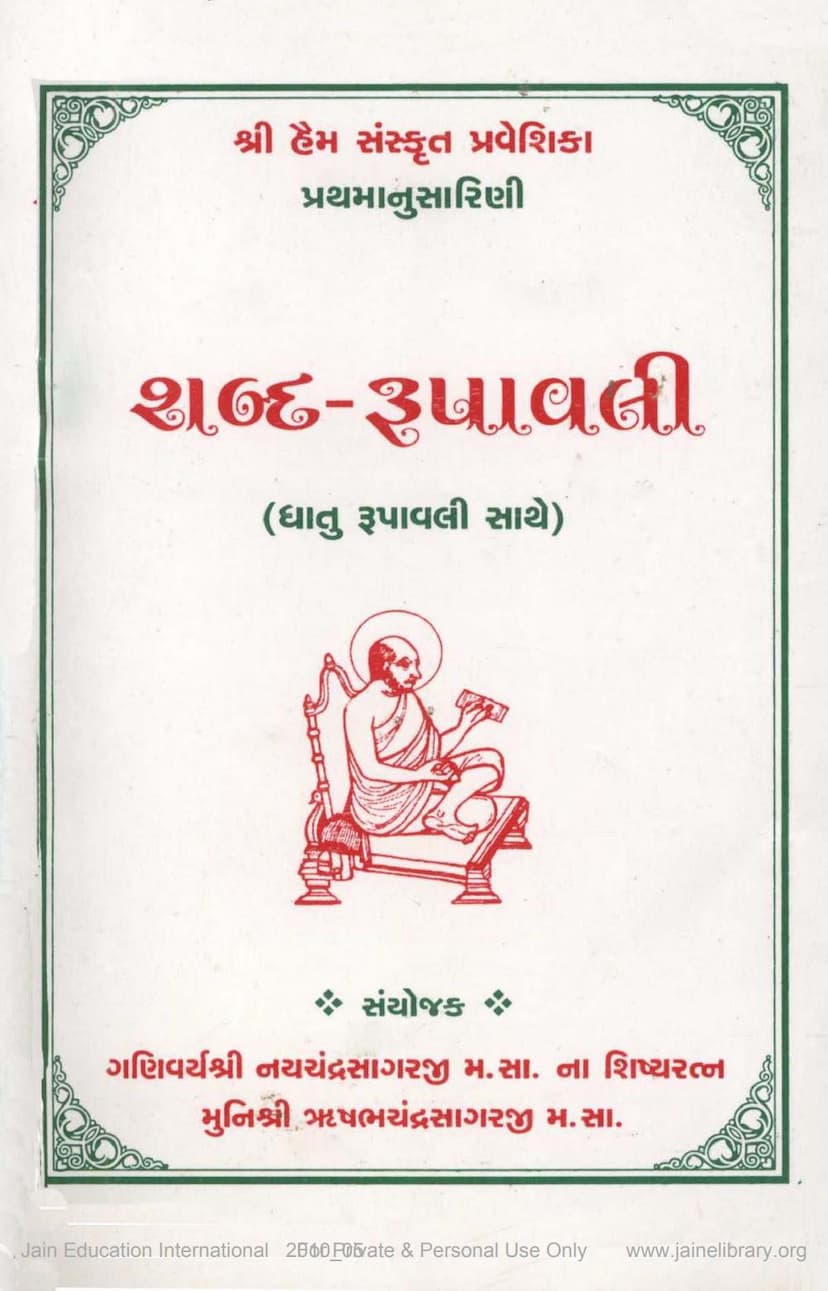Shabdarupavali
Added to library: September 2, 2025
Loading image...

Summary
This document is a comprehensive guide to Sanskrit word and verb conjugations, specifically designed to complement the "Haim Sanskrit Praveshika Prathama" (First Part), a foundational text for learning Sanskrit within the Jain tradition.
Key aspects of "Shabdarupavali" (with Dhatu Rupavali):
- Purpose: The book aims to provide a strong foundation in Sanskrit by systematically presenting the various forms (rupas) of nouns (shabda) and verbs (dhatu). It acknowledges the importance of rote memorization in mastering Sanskrit grammar, as stated by experienced scholars.
- Target Audience: While intended for all Sanskrit learners, it is particularly beneficial for primary students and young munis (monks) within the Jain Sangha who are studying the Haim Sanskrit system. The book is structured for easy memorization and comprehension.
- Author and Publisher: Authored by Muni Shri Rishabhchandrasagarji M.S., a disciple of Ganivarya Shri Nayachandrasagarji M.S. It is published by Purnanand Prakashan, Ahmedabad.
- Content Structure:
- Introduction and Guidance (Abhyasuone Margadarshan): Offers guidance on how to use the book effectively, emphasizing the memorization of introductory shlokas.
- Word and Verb Collections (Shabda-Sangrah Shloka and Dhatu-Sangrah Shloka): Includes verses that list the words and verbs covered in the book, aiding in memorization and organization.
- Word Forms (Shabdarupa): The core of the book, presenting the declensions of a vast array of Sanskrit nouns and pronouns. This includes:
- Nouns: Covers masculine, feminine, and neuter genders, and various endings (e.g., 'a'-ending, 'i'-ending, 'u'-ending, consonant-ending, etc.). Examples include "bal" (boy), "kamal" (lotus), "mala" (garland), "muni" (sage), "bhanu" (sun), "nadi" (river), "vadhu" (bride), "marut" (wind), "jagat" (world), "pitṛ" (father), "matṛ" (mother), "kartṛ" (doer), and many others.
- Pronouns: Includes declensions for personal pronouns ("aham" - I, "tvam" - you), demonstrative pronouns ("tad" - that, "etad" - this, "adas" - that, "idam" - this), interrogative pronouns ("kim" - what/who), relative pronouns ("yad" - who/which), and indefinite pronouns (e.g., "kashchit" - someone, "kashchan" - someone, "ko'pi" - anyone).
- Verbs (Dhaturupa): Presents conjugations for various verb roots in different tenses and moods, including present tense (vartaman), past tense (hyastan bhutkal), imperative mood (aagnarth), and potential mood (vidhyarth). It covers verbs from different classes (Ganas) of Sanskrit grammar. Examples include "nam" (to bow), "vand" (to worship), "vṛṣ" (to rain/strengthen), "bhū" (to be), "dīp" (to shine), "nṛt" (to dance), "sphuṭ" (to break/split), "diś" (to show), "chint" (to think), "arth" (to pray), "chur" (to steal), "tāḍ" (to strike), "pṛ" (to fill), and "kath" (to tell).
- Appendices (Parishisht):
- Appendix 1 (Vibhakti Bodhak Pratyayona Gujarati Arth): Explains the meaning of Sanskrit case endings (vibhakti) in Gujarati, providing a crucial link for understanding usage.
- Appendix 2 (Rupo Yad Rakhavani Saral Rit): Offers tips and methods for easily memorizing the word and verb forms.
- Appendix 3 (Abhiprayo): Includes testimonials and endorsements from various respected Acharyas and scholars, highlighting the book's utility and quality.
- Key Features:
- Follows Haim Sanskrit Praveshika: The organization and presentation of word forms closely align with the first part of the "Haim Sanskrit Praveshika," making it a natural supplement.
- Comprehensive Coverage: It includes a significant number of commonly used Sanskrit words and verb roots, covering various grammatical categories and declensional patterns.
- Dual Approach: The book provides both word forms (Shabdarupa) and verb forms (Dhaturupa) in a single volume, offering a holistic approach to Sanskrit grammar.
- Clear Presentation: The text is presented in Gujarati script, making it accessible to Gujarati-speaking learners. The layout is clear, with page numbers and case distinctions clearly marked.
- Multiple Editions: The book has seen multiple printings (1st edition in Samvat 2059, 2nd in 2060, 3rd in 2061), indicating its popularity and usefulness.
- Errata and Improvements: The second edition specifically mentions incorporating improvements based on suggestions, including passive verb forms (karmaṇi rūpa), lesson numbers for root words, and an appendix for ease of memorization.
In essence, "Shabdarupavali" by Muni Shri Rishabhchandrasagarji is a meticulously compiled and highly practical resource for anyone seeking to master the foundational grammatical structures of Sanskrit, particularly within the framework of Jain scriptural studies. It aims to simplify the often daunting task of learning Sanskrit conjugations and declensions, making the language more accessible to a wider audience.